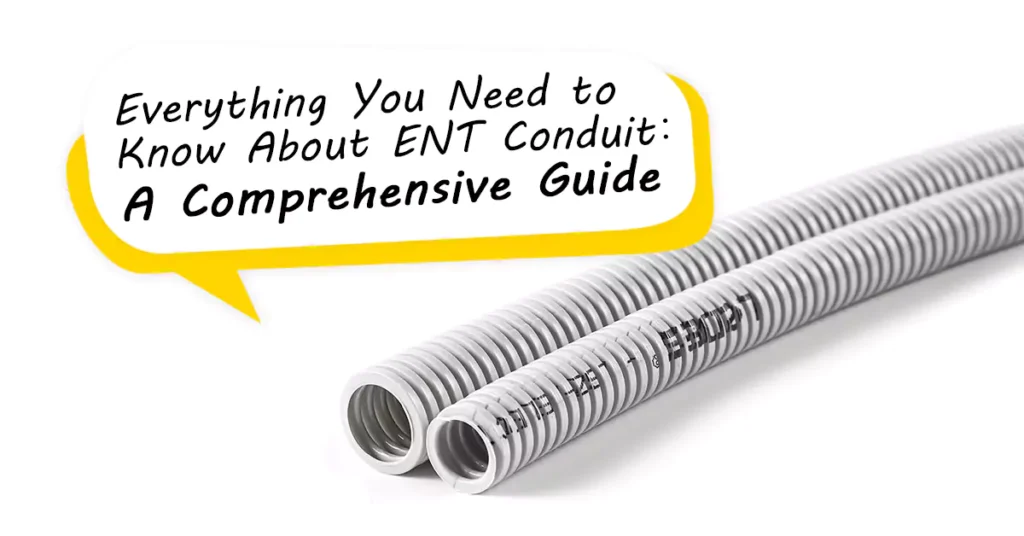
Inhaltsverzeichnis
HNO verstehen
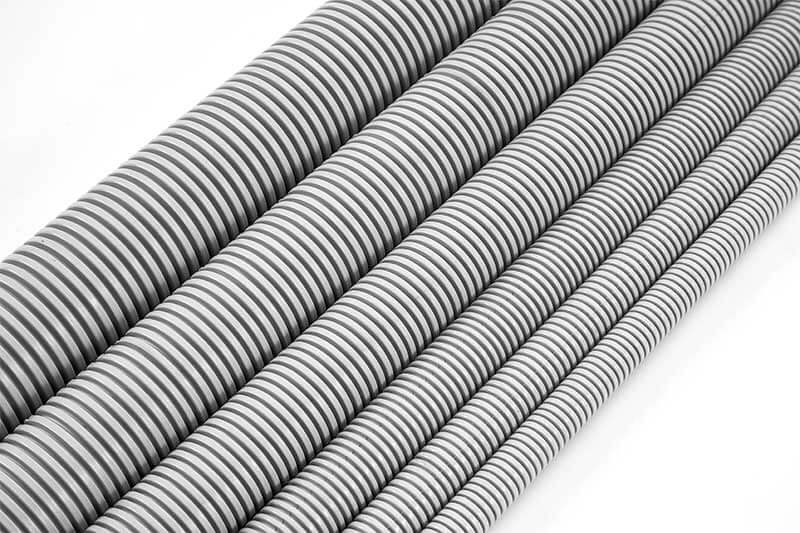
Elektrische nichtmetallische Rohre (ENT) is a type of conduit used for electrical installations. It is a flexible, corrugated tube made of a non-metallic material, typically a high-quality plastic such as PVC (polyvinyl chloride).ENT conduit offers several advantages over traditional metallic conduits. It is lightweight, easy to handle, and can be easily cut and bent to fit various installation requirements. The flexibility of ENT allows for easier installation in tight spaces and around obstacles. ENT is designed to protect and route electrical wires and cables, serving as a pathway for electrical wiring in residential and commercial buildings.
Konforme Zertifikate und Teststandards
Die für nichtmetallische elektrische Rohre (ENT) erforderlichen Zertifizierungs- und Prüfnormen können je nach Region und spezifischen elektrischen Vorschriften unterschiedlich sein. Hier sind jedoch einige häufig zitierte Normen und Tests für ENT:
- UL 1653: UL 1653 ist der anerkannte Standard für nichtmetallische elektrische Rohre (ENT). Er deckt die Sicherheits- und Leistungsanforderungen für ENT-Produkte ab, einschließlich Abmessungen, Konstruktion, Materialien und Prüfmethoden.
- CSA C22.2 Nr. 227.1: CSA C22.2 No. 227.1 is a Canadian standard that outlines the requirements for nonmetallic tubing used for electrical installations, including ENT. It covers materials, construction, dimensions, performance, and testing methods specific to ENT.
- FT4: Der FT4-Test ist nicht spezifisch für elektrische nichtmetallische Rohre (ENT), sondern ein Feuerwiderstandstest zur Bewertung der Flammenausbreitungseigenschaften von Kabeln. Der FT4-Test wird normalerweise an Kabeln durchgeführt, einschließlich jener, die in oder neben ENT-Leitungen installiert werden können.
Der FT4-Test ist Teil des Standards C22.2 Nr. 0.3 der Canadian Standards Association (CSA), der Flammenausbreitungs- und Rauchdichtetests für Kabel abdeckt. Der Test misst die Flammenausbreitungsbewertung eines Kabels, indem es einer vertikalen Flammenzündquelle ausgesetzt wird. Der Test bewertet die Fähigkeit des Kabels, der Flammenausbreitung zu widerstehen, und sein Potenzial, bei einer vertikalen Installation eine Brandausbreitung zu verursachen.
- NEC (Nationaler Elektrocode): Der NEC ist ein in den USA weit verbreiteter Standard, der Richtlinien und Vorschriften für elektrische Installationen bereitstellt. Er enthält Anforderungen für die Verwendung von Leitungen, einschließlich ENT, wie z. B. die richtige Dimensionierung, Installationsmethoden und Erdung.
Die Einhaltung dieser Normen und der Besitz der entsprechenden Konformitätszertifikate sind bei der Auswahl von HNO-Leitungen von entscheidender Bedeutung.
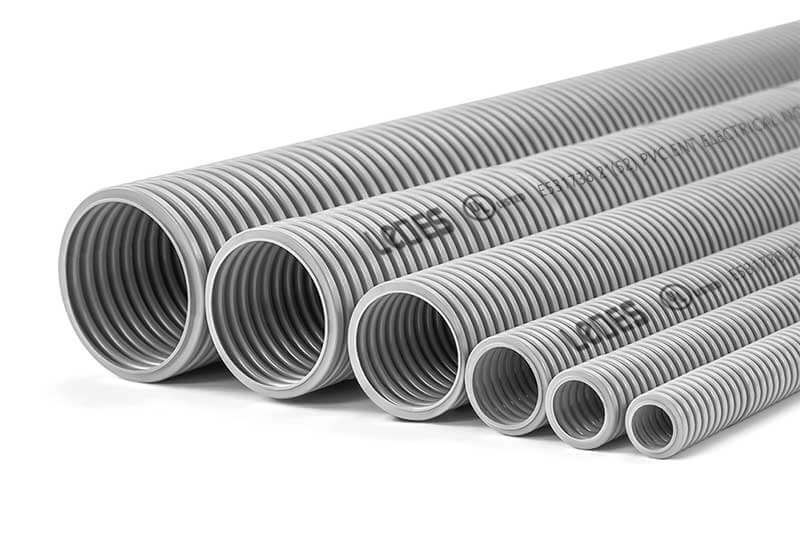
Normale Größen von HNO-Conduits
ENT-Leitungen sind in verschiedenen Größen erhältlich, um unterschiedlichen Verdrahtungsanforderungen gerecht zu werden. Die gängigsten Größen sind 1/2 Zoll bis 2-1/2 Zoll. Diese Größen ermöglichen Flexibilität bei der Verlegung und Aufnahme der für eine bestimmte Anwendung erforderlichen Anzahl von Drähten.
ENT Conduit Manufacturing Process
HNO-Rohre werden im Extrusionsverfahren hergestellt. Für PVC-HNO-Rohre benötigen Sie:
Materialien:
PVC resin: The primary raw material for PVC conduit.
Stabilizers: Additives that enhance the stability and durability of the PVC.
Plasticizers: Substances that improve the flexibility of the PVC.
Lubricants: Used to facilitate the extrusion process.
Pigments: Optional additives for coloration.
Ausrüstung:
PVC extruder: A machine used to melt and mix the PVC resin with additives.
Extrusion die: Forms the PVC into the desired conduit shape.
Cooling system: Rapidly cools and solidifies the extruded PVC.
Cutting and sizing equipment: Cuts the conduit to the desired length and ensures proper sizing.
Printing equipment: If necessary, equipment for printing product information or markings on the conduit.
The manufacturing process generally involves the following steps:
Preparation: The PVC resin, stabilizers, plasticizers, lubricants, and pigments are weighed and mixed according to specific formulations.
Extrusion: Die gemischten Materialien werden in den PVC-Extruder geleitet, wo sie erhitzt und geschmolzen werden. Das geschmolzene PVC wird dann durch die Extrusionsdüse gepresst, die es in das Rohrprofil formt.
Kühlung: Das extrudierte PVC-Rohr durchläuft ein Kühlsystem, das es schnell abkühlt, bis die Form fest ist.
Cutting and sizing: The cooled conduit is cut to the desired length and undergoes sizing to ensure it meets the required dimensions.
Printing (if applicable): If product information or markings are required on the conduit, printing equipment can be used to add them.
Quality control: The finished PVC ENT conduit undergoes quality checks to ensure it meets the required standards and specifications.
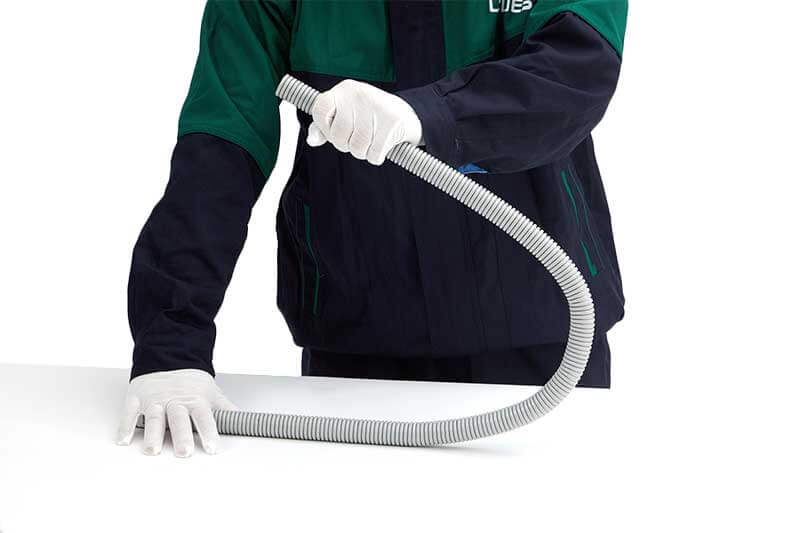
Vorteile des ENT-Conduits
ENT-Rohre bieten gegenüber herkömmlichen Metallrohren mehrere Vorteile. Dazu gehören:
- Flexibilität: ENT-Rohre sind äußerst flexibel und können leicht von Hand gebogen werden. Dies erleichtert das Verlegen durch enge Räume und um Ecken, verringert den Bedarf an Armaturen und vereinfacht die Installation.
- Korrosionsbeständigkeit: Unlike metal conduits, ENT conduit is immune to corrosion, making it suitable for outdoor and damp environments.
- Leicht: ENT conduit is significantly lighter than metal conduits, allowing for easier handling and installation.
- Kosteneffizient: ENT conduit is generally more affordable than metal conduits, making it a cost-effective choice for electrical installations.
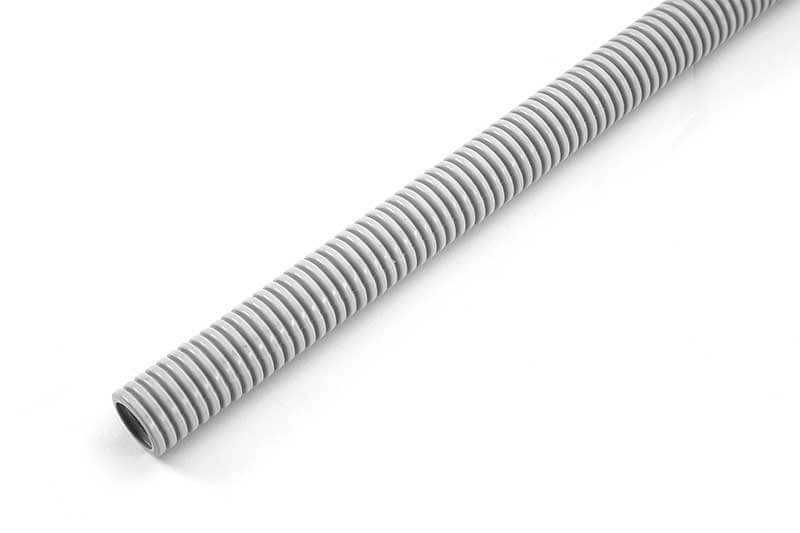
Häufige Verwendungsszenarien
Electrical Nonmetallic Tubing (ENT) is a versatile and efficient conduit solution widely used in various wiring applications. Its flexible design and resistance to environmental factors make it an ideal choice for both residential and commercial settings. Below are detailed common usage scenarios for ENT:
Hausverkabelung
ENT conduit is particularly beneficial for homeowners looking for discreet and efficient wiring solutions.
- Integrated In-Wall Systems: ENT conduit provides smooth routing for electrical runs within walls, reducing the need for complex re-routing around studs and other built-in obstacles.
- Bathroom and Kitchen Circuits: ENT’s moisture resistance and compact flexibility make it ideal for these high-use areas, where it safely supports wiring for outlets, lighting, and appliances.
- Dedicated Circuits for Appliances: ENT allows for organized, dedicated circuits for large appliances, ensuring they are correctly wired while minimizing clutter, especially in basements or utility rooms.
Commercial Applications
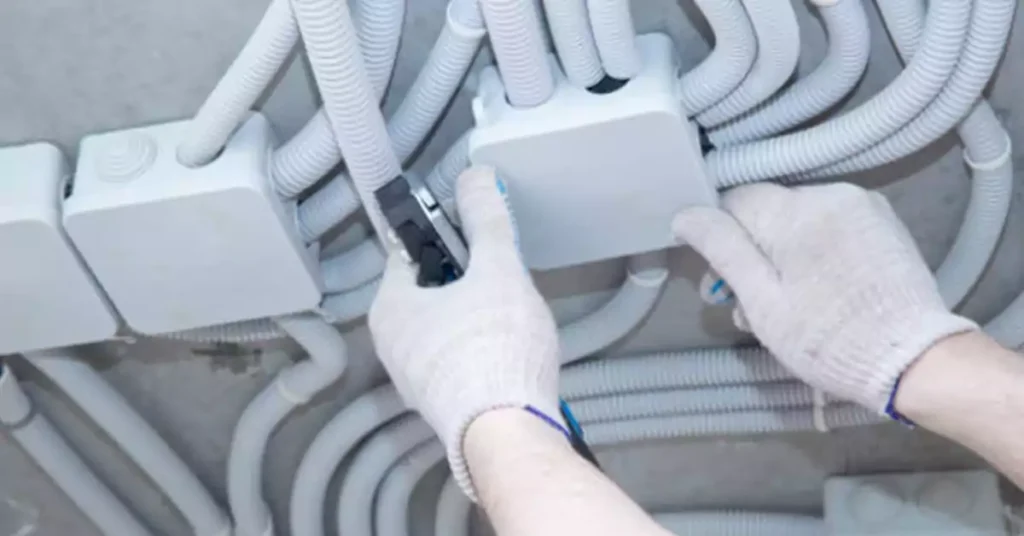
ENT conduit is also invaluable in commercial buildings, providing efficient wiring solutions for various business needs:
- Office Wiring: In office environments, ENT facilitates the organization of wiring for workstations, lighting fixtures, and data networks. Its flexibility allows for easy adjustments and reconfigurations as office layouts change.
- Retail Spaces: Retail spaces benefit from ENT’s ability to create a clean and organized electrical system. It supports wiring for point-of-sale terminals, display lighting, security systems, and more, ensuring that the electrical setup does not detract from the shopping experience.
- Light Commercial Buildings: Smaller businesses, such as restaurants, salons, and clinics, utilize ENT for reliable wiring solutions. Its adaptability makes it suitable for various setups, from kitchen equipment to lighting and HVAC systems.
Industrial Settings
While ENT may not be the first choice for heavy-duty industrial applications due to its limited strength, it still finds specific niches:
- Low-Voltage Systems: ENT conduit provides safe, adaptable routing for control systems, instrumentation, and monitoring equipment, allowing for flexibility in sensor placements and adjustments.
- Light Machinery and Conveyors: In controlled environments, ENT conduit can house wiring for lighter machinery, sensors, and control panels, providing protection and organization while allowing for future adaptability.
- Data and Communication Lines: ENT is increasingly used for low-voltage data and communication lines within controlled industrial setups, supporting a hybrid of electrical and data management.
Außenanwendungen
ENT conduit is also suitable for outdoor installations, providing protection against moisture and environmental factors. This makes it a reliable choice for outdoor lighting, landscape lighting, and other exterior electrical needs.
Concrete Slab Installations
ENT is a popular choice for installations beneath concrete slabs. Its design allows it to withstand the weight of concrete and resist damage during the curing process, ensuring a durable electrical solution.
ENT Conduit vs Liquid-tight Conduit: Key Differences
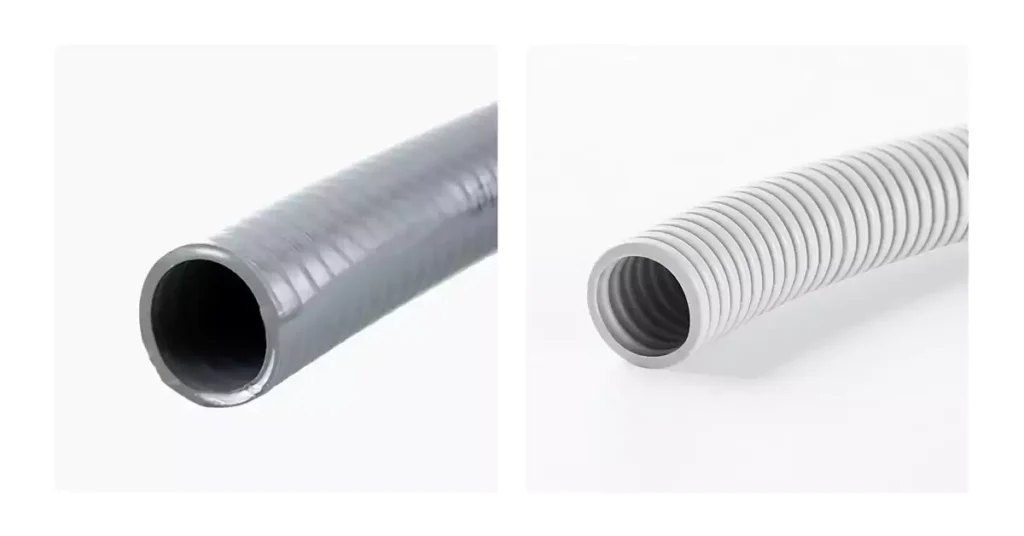
When it comes to electrical installations, the choice of conduit is crucial for ensuring safety, durability, and compliance with electrical codes. Two common types of conduit are Electrical Nonmetallic Tubing (ENT) and Liquid-tight Conduit. While both serve the purpose of protecting electrical wiring, they possess distinct characteristics that make them suitable for different applications.
6 Differences of ENT Conduit vs Liquid-tight Conduit
- Materialzusammensetzung:
- ENT Conduit: Made from durable plastic, ENT conduit is lightweight and flexible, often chosen for indoor applications.
- Flüssigkeitsdichte Leitung: Constructed with a flexible metal core and a protective outer layer, it is highly resistant to water, oil, and chemicals, suitable for outdoor and wet environments.
- Construction
- ENT: Features a smooth interior surface that facilitates wire pulling and is often available in various diameters.
- Flüssigkeitsdichte Leitung: Includes a watertight design with a smooth or corrugated exterior, providing additional protection against environmental factors.
- Feuerbeständigkeit
- ENT: Generally has a lower fire resistance rating, primarily depending on the specific product and manufacturer.
- Flüssigkeitsdichte Leitung: Typically offers better fire resistance, particularly in metal options, making it more suitable for high-risk environments.
- Korrosionsbeständigkeit
- ENT: Naturally resistant to corrosion, making it ideal for damp or wet locations.
- Flüssigkeitsdichte Leitung: Also resistant to corrosion, but metal versions may be susceptible over time if exposed to harsh chemicals.
- Flexibility and Strength
- ENT: Known for its high flexibility, it’s easy to route around obstacles and within walls. However, it lacks the structural strength of metal conduits.
- Flüssigkeitsdichte Leitung: Offers moderate flexibility with added durability, holding up well in environments requiring resistance to physical impacts.
- Temperature Tolerance
- ENT: Performs best in temperature-controlled environments and can become brittle in extreme temperatures.
- Flüssigkeitsdichte Leitung: Built to handle a broader range of temperatures, it’s suitable for use in both indoor and outdoor conditions, including exposure to temperature fluctuations.
Best Suited Applications
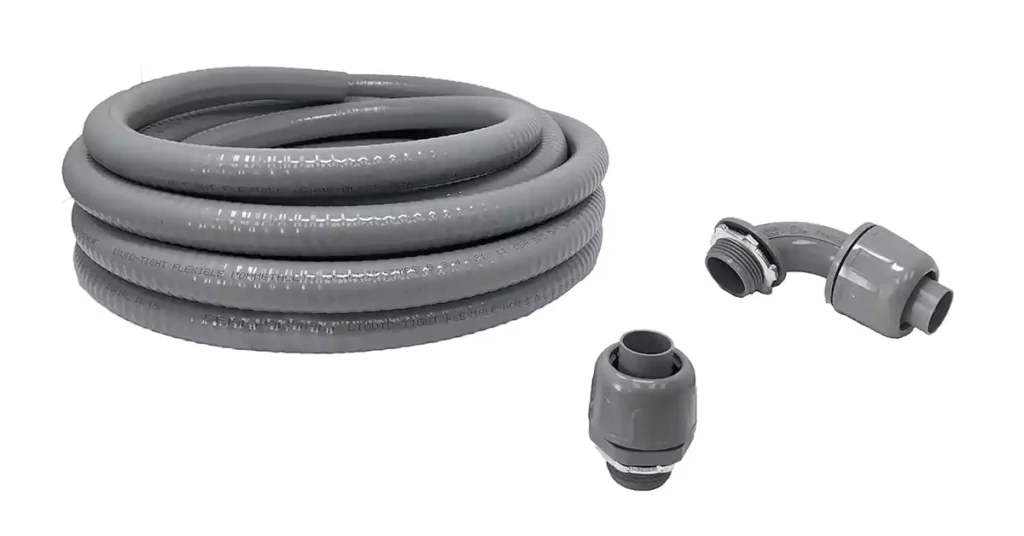
Elektrische nichtmetallische Schläuche (ENT)
ENT is best suited for indoor applications where flexibility and ease of installation are prioritized. Common uses include:
- Residential wiring in walls and ceilings.
- Low-voltage applications.
- Areas where moisture is present but not excessive.
Liquid-tight Conduit
Liquid-tight conduit is ideal for environments where exposure to moisture, chemicals, or physical damage is a concern. Common applications include:
- Outdoor installations and exposed areas.
- Industrial settings where electrical equipment may be subject to spills or harsh cleaning processes.
- Wet locations as defined by the National Electrical Code (NEC).
Electrical Code Requirements for ENT Installation
Proper installation is crucial not only for the longevity of the conduit but also for the safety and functionality of the electrical system. Here are some essential installation steps and considerations to ensure a safe and compliant setup of ENT systems.
Key Steps in ENT Installation
The process for installing ENT conduit typically follows these essential steps to ensure both functionality and compliance with the National Electrical Code (NEC) and any local regulations:
- Planning the Layout: Determine the route for the conduit, considering wall studs, joists, and other structural components, and ensuring minimal bends to reduce stress on wiring.
- Cutting and Fitting the Conduit: Cut the conduit to appropriate lengths using a conduit cutter, then use approved fittings to connect sections and form desired angles.
- Securing the Conduit: Mount the conduit using appropriate clamps, brackets, or hangers, adhering to spacing requirements for support—typically every 3-4 feet or as specified by the NEC.
- Connecting to Boxes and Fixtures: Secure conduit to junction boxes or fixtures with approved connectors, making sure connections are tight and moisture-resistant for durability and safety.
- Pulling Wires: Carefully pull wiring through the ENT, being mindful of insulation integrity. Code guidelines may restrict specific cable types or sizes for use within ENT conduit, so verify compatibility.
- Inspecting and Testing: Once installed, inspect the entire conduit path for continuity, secure fittings, and adherence to code before finalizing wiring.
Key Considerations for ENT Conduit Installation
Support and Spacing: Adhere to the required support spacing to prevent sagging or conduit movement, which can lead to wiring strain or insulation damage. Mount securely, especially in horizontal runs, where additional support may be necessary.
Biegeradius: Follow code guidelines on maximum bending radius to avoid wire damage or excessive friction during pulls. Consider using pull boxes for long runs or runs with multiple bends to facilitate smooth wire installation and reduce potential wear.
Environmental Limitations: ENT conduit is ideal for indoor and dry applications but may require specific conduit ratings or protection for outdoor, high-heat, or damp locations. Consult code restrictions based on location to ensure environmental compatibility.
Connection Quality: Properly tighten all connections to prevent loosening over time. Loose fittings can expose wires or cause electrical faults, so secure each connection according to NEC requirements.
Erdung und Verbindung: In some cases, ENT may require grounding, particularly in installations where conduit continuity is essential. Consult the NEC or local codes to determine if additional grounding measures are necessary based on the application.
Labeling and Identification: For complex installations, labeling conduit sections and junction boxes improves maintenance efficiency and complies with code requirements for traceability.
Troubleshooting Common ENT Conduit Installation Issues
Even with careful planning, ENT installations can encounter challenges. Here are some common issues and how to address them:
Loose Fittings or Connections: Loose connections can lead to conduit displacement or gaps, compromising the integrity of the installation. Recheck fittings and connectors, ensuring they are code-approved and securely fastened.
Difficult Wire Pulling: If wires are difficult to pull through, check for excessive bends, long conduit runs without pull boxes, or rough-cut edges. Lubricate wires if allowed by code, or add pull boxes as needed.
Conduit Sagging: If ENT conduit sags between supports, review the spacing and add additional supports if necessary. Sagging can place strain on the wiring, increasing the risk of insulation damage or wire abrasion.
Moisture Intrusion in Outdoor or Wet Locations: For installations in damp environments, ensure all fittings and seals are waterproof and adhere to code requirements for moisture protection. ENT conduit is generally recommended for dry locations, so use caution when planning for damp or outdoor settings.
Conduit Damage: ENT conduit can be damaged during installation or if subjected to high-impact areas. Inspect the conduit for any cracks or abrasions, and replace damaged sections to maintain electrical safety.
Cutting ENT Conduit: Tips and Techniques
Achieving clean, accurate cuts on ENT conduit is vital for a smooth installation. Improper cuts can lead to irregular edges, causing difficulties in fitting connections and potentially compromising the conduit’s integrity over time. Additionally, precise cuts ensure a secure connection with fittings, reducing the risk of electrical hazards, moisture intrusion, and maintaining NEC compliance.
Tools for Cutting ENT Conduit
Several tools can effectively cut ENT conduit, each with unique advantages. Here’s a breakdown:
- ENT Conduit Cutters: These cutters are specifically designed for the task, delivering smooth cuts quickly and with minimal effort.
- Säge: A more accessible tool, though it can leave rough edges requiring additional deburring.
- Rotary Pipe Cutters: Known for precision, these cutters are often preferred for small-diameter conduit. They work well with softer plastic materials.
- Utility Knife: Useful for scoring smaller conduit diameters; it’s not the most efficient but can be a practical option in a pinch.
Key Techniques for an Efficient Cut
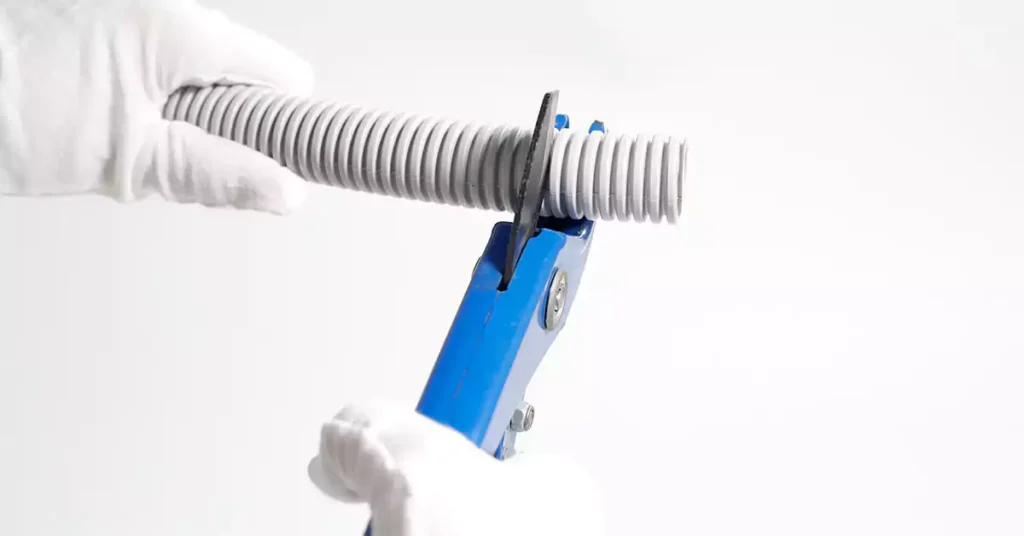
To ensure that ENT conduit cuts are smooth and precise, here are some best practices:
- Measure Twice, Cut Once: Accuracy in measuring is essential for proper installation. Mark your desired cut line clearly with a pencil or marker.
- Stabilize the Conduit: Secure the conduit firmly to prevent movement during cutting, which can lead to uneven edges.
- Rotate the Conduit (If Applicable): For certain cutting methods, rotating the conduit while applying gentle pressure can yield a smoother cut.
- Kanten entgraten: After cutting, use a deburring tool or sandpaper to smooth any rough edges, which can prevent injuries and ensure a snug fit with fittings.
Safety First
When working with ENT conduit, safety should always be a priority. Here are a few safety tips:
Schutzausrüstung tragen: Safety goggles, gloves, and a dust mask protect you from sharp edges, debris, and any small particles that may become airborne during cutting.
Secure the Workspace: Ensure your workspace is clear of any obstructions and has good lighting to prevent accidental injuries.
Handle Blades Carefully: Sharp tools require cautious handling, so always use proper technique and store tools securely when not in use.
Securing ENT Conduit to Surfaces: Clamps & Supports
Why Proper Conduit Securing is Essential
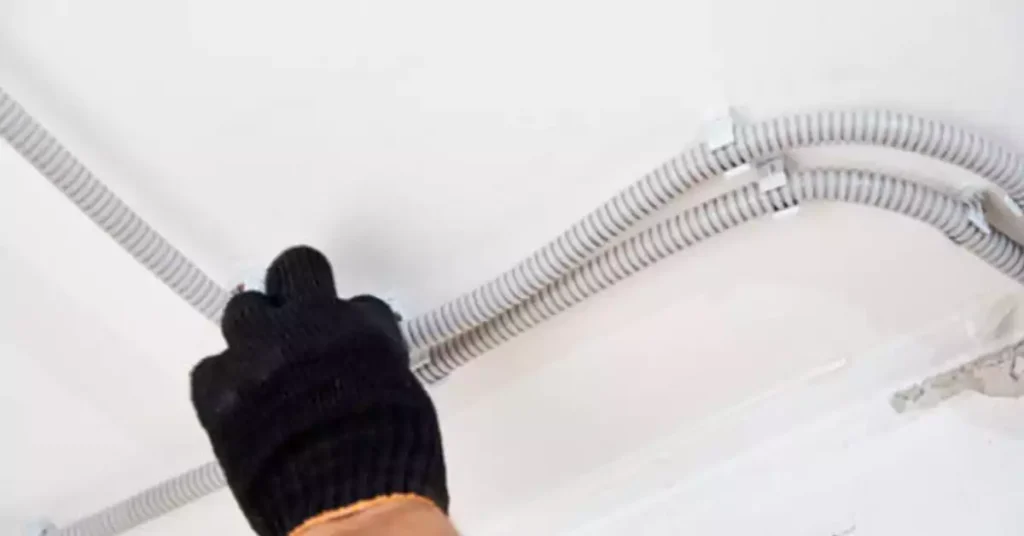
Correctly mounted conduit not only safeguards electrical wiring but also prevents various physical stresses that could otherwise lead to safety risks. ENT conduit that is not adequately secured may swing, sag, or chafe against surfaces, which can damage both the conduit and wiring inside. This type of movement introduces risk factors for electrical hazards and mechanical wear over time, making a reliable mounting strategy crucial.
Functional Stability and Safety
To maintain system integrity, ENT conduit must be fixed securely to resist movement, bending, and sagging. This is particularly critical for heavier wiring loads, as the added weight can pull the conduit downward if left unsupported. Reliable securing minimizes these risks and extends the lifespan of the installation, keeping wiring protected and functional.
Essential Tools and Types of Clamps and Supports
A range of clamps and hangers are designed specifically to keep ENT conduit firmly mounted on surfaces like walls, ceilings, and structural beams. Here’s a look at the most commonly used mounting tools:
Strap Clamps: These versatile, wrap-around clamps provide a straightforward way to secure ENT conduit, typically fastening with a single screw or bolt for quick installation.
C-Clamps: C-shaped clamps offer additional gripping power for stability, particularly useful on installations that may face minor vibrations or pressure.
Conduit Hangers: When ENT conduit is suspended from above (e.g., in basements or under floors), conduit hangers are essential. These come in various types, including:
- Wire Hangers: Loops of wire threaded through the conduit that provide a minimalist solution, often used in lighter load applications.
- Metal Conduit Hangers: For heavier-duty applications, metal hangers offer adjustable arms for precise positioning and secure support, suitable for larger conduit runs.
To attach these components, a drill and correctly sized drill bits are necessary for creating mounting holes in the surfaces and attaching screws or bolts without damaging the conduit or its surrounding materials.
Mounting Techniques for Optimal Stability
For a reliable installation, consider these mounting strategies that enhance security and performance:
Spacing Requirements: Space clamps and hangers appropriately—usually every 4-6 feet—for effective support and to keep the conduit level. This spacing prevents sagging, especially for runs that extend over longer distances.
Adapting to Surface Type: Choose the right mounting hardware based on the type of surface (e.g., masonry, wood, drywall) to prevent mounting failures or slippage.
Avoiding Over-Tightening: Tighten fasteners securely but avoid over-tightening, which can damage both the conduit and the mounting surface, potentially leading to premature failure.
Fittings and Junction Boxes for Professional-Grade Installations
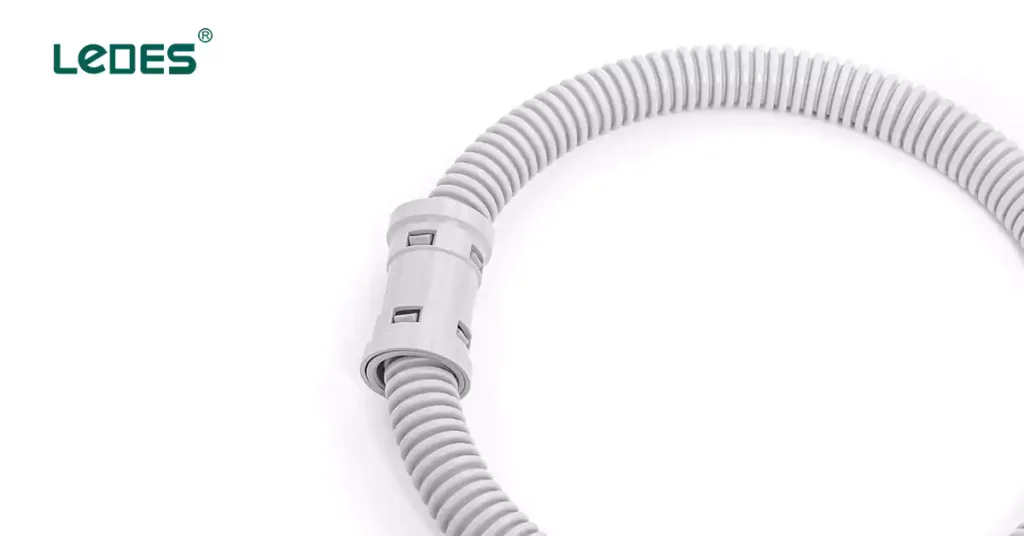
To complete a secure conduit system, fittings and junction boxes are critical components that ensure stable connections and directional changes:
ENT Fittings: Designed to lock conduit in place at joints, corners, and bends, these fittings keep ENT conduit well-aligned and prevent disconnection. Many fittings are also available with weatherproof and corrosion-resistant features for durability.
Junction Boxes: Often installed where multiple conduit runs meet or diverge, junction boxes house wiring connections safely and streamline wiring organization. For convenience, pre-wired junction boxes with integrated support for conduit runs can reduce installation time and simplify wiring configurations.
Installation Tips for Long-Term Reliability
To get the most out of your ENT conduit system, consider the following tips:
Consult Building Codes: Local building codes provide specific requirements on conduit spacing, mounting methods, and securing materials to ensure safe and compliant installations.
Weather and Environment Considerations: In outdoor or high-moisture environments, opt for UV-resistant or moisture-proof supports to maintain longevity and avoid damage from exposure.
Avoid Sharp Bends: Use gradual bends and avoid sharp angles in the conduit to protect the wiring from stress or abrasion that can lead to insulation wear.
Junction Boxes and Their Use with ENT Conduit
What is a Junction Box?
A junction box is a protective enclosure where electrical wiring connections are housed. Commonly made from durable materials like metal or plastic, these boxes shield electrical connections from physical damage, environmental hazards, and unauthorized tampering. When working with ENT (Electrical Nonmetallic Tubing) conduit, junction boxes become essential for both safety and functionality, providing secure junctions where wires meet or branch out. In this guide, we’ll explore why junction boxes are crucial when installing ENT conduit, how to select the best box for your needs, and the steps to safely install them.
Why Use Junction Boxes with ENT Conduit?
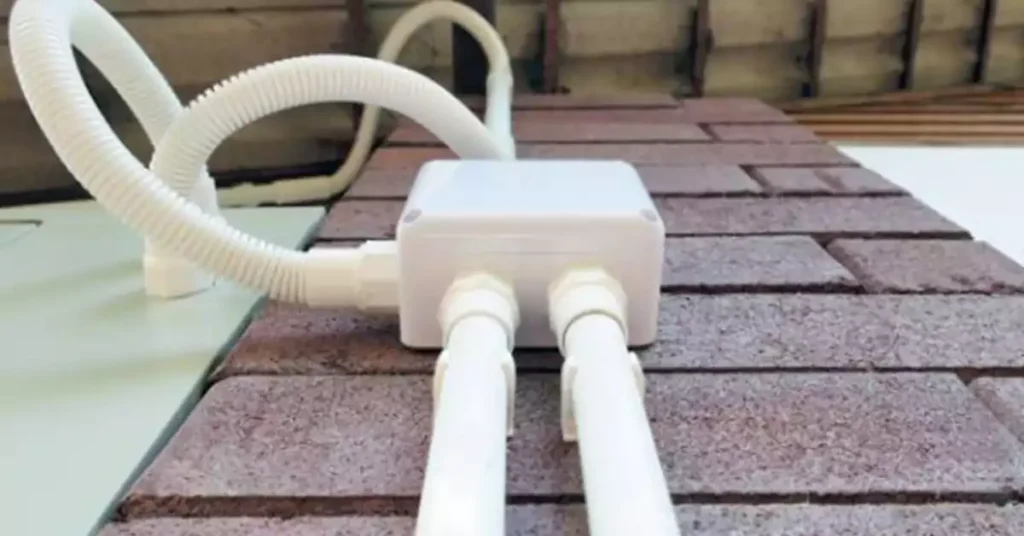
Safety
Junction boxes reduce electrical hazards by providing a secure enclosure for wire connections, lowering the risk of electrical shocks or fire. They also prevent accidental contact with live wires and protect against physical wear.
Simplified Maintenance
By centralizing connections, junction boxes allow for easier access to wiring for repairs or upgrades. This is especially useful in large installations where numerous wires converge.
Einhaltung
In most regions, electrical code compliance requires junction boxes for all wiring splices or joints. This ensures that installations are safe, orderly, and protected from external factors like dust, moisture, and physical damage.
Choosing the Right Junction Box for ENT Conduit
Selecting a suitable junction box involves considering factors like location, size, material, and connection types:
Material: Plastic junction boxes are often used with ENT conduit due to their corrosion resistance, while metal boxes are better for areas with high temperatures or stringent fire safety requirements. Ledes’ junction boxes are made from high quality PVC, which are resistant to corrosion, sunlight, and non-conductive, ensuring a safe and reliable electrical installation.
Size: Choose a box large enough to accommodate all wires and fittings without crowding. Crowded boxes can increase heat buildup and make maintenance more challenging.
Ingress Protection (IP) Rating: In damp or outdoor locations, select a box with a high IP rating to ensure it can withstand exposure to moisture or dust.
Installation Steps for Junction Boxes with ENT Conduit
- Plan the Location: Determine where the junction box will be installed, making sure it is easily accessible for future maintenance. For secure installation, use a stud or other structural support.
- Prepare the Conduit and Box: Measure the conduit and cut it to the appropriate length for connecting to the junction box. Use ENT specific fittings for a seamless connection.
- Sichern Sie die Box: Attach the junction box to the mounting surface using screws or bolts, ensuring it is level and secure.
- Connect the Conduit: Insert the ENT conduit into the box openings and fasten with appropriate connectors. Make sure all connections are tight and follow NEC (National Electrical Code) requirements.
- Wire and Close: Inside the box, connect and organize the wiring as required, using wire nuts to cap connections. Carefully fold wires into the box and secure the cover tightly to prevent tampering and protect from dust or moisture.
Safety Tips
Strom ausschalten: Always switch off power at the circuit breaker before handling electrical components to prevent shock or injury.
Verwenden Sie die richtigen Werkzeuge: Use tools designed for electrical work, such as insulated screwdrivers and wire strippers, to enhance safety.
Avoid Overcrowding: Ensure that the box is large enough for all wires and connectors. An overcrowded box can lead to overheating and increases fire risk.
Verify Grounding: Proper grounding is essential to prevent electrical shocks and ensure that all connections are secure.
Pulling Wire Through ENT Conduit: Essential Techniques
Pulling wire through Electrical Nonmetallic Tubing (ENT) conduit requires careful planning and technique to ensure a smooth, safe installation. ENT conduit, known for its flexibility and lightweight design, can simplify wiring runs, but it also requires specific handling to avoid wire damage or snags. This guide will briefly cover key techniques and tools for efficiently pulling wire through ENT conduit.
Key Techniques for Pulling Wire Through ENT Conduit
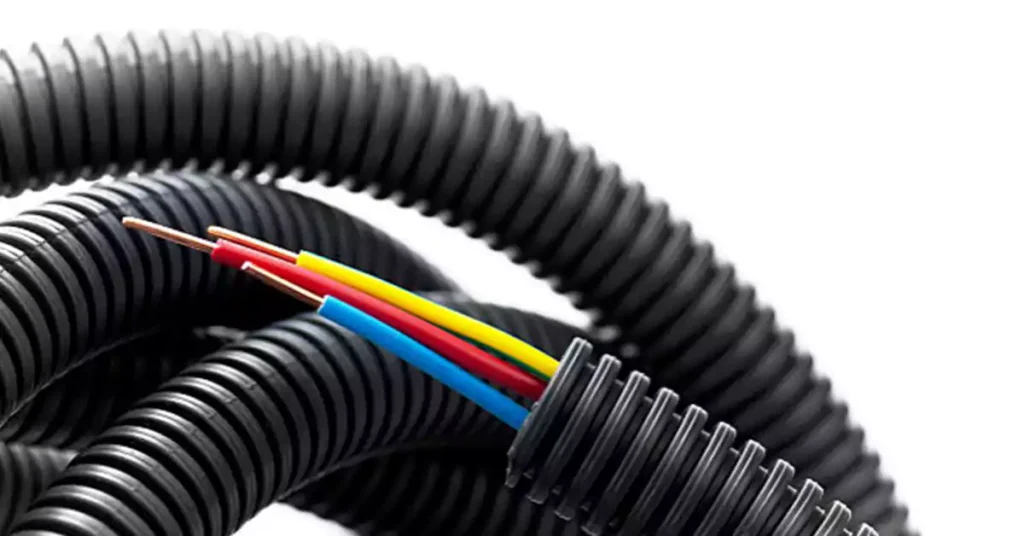
- Prepare the Conduit Path
Start by ensuring the conduit is free of obstructions and tightly secured along its path. Properly spaced clamps help keep the conduit straight and prevent unwanted bends or kinks during wire pulling. - Use Pulling Lubricant
Applying a wire-pulling lubricant can reduce friction, especially on longer or complex runs. This helps the wires slide smoothly through the conduit without risking insulation damage. - Select the Right Tools
Use a fish tape or pull line to guide wires through the conduit. Fish tape is particularly useful for shorter runs, while pull lines work well for longer distances or bends. Attach the wires securely and feed them slowly to avoid twists and tangles. - Pull Gently and Consistently
Apply steady, even pressure when pulling to prevent wire binding. If resistance increases, stop and check for obstructions or tight bends in the conduit that may need adjusting. - Avoid Overloading the Conduit
Refer to NEC guidelines to ensure the conduit size matches the wire fill requirements. Overloading can lead to overheating and make future maintenance difficult.
For a more detailed about the wire pulling, please refer to the previous article for how to pull wire through the conduit.
Conduit Fill Calculator: Determining Maximum Capacity
When planning electrical conduit installations, calculating conduit fill is essential to ensure compliance with safety codes and to prevent issues related to overheating or overcrowded wires. A conduit fill calculator helps electricians and installers determine the maximum capacity of wires for each conduit size, factoring in wire type, size, and insulation. Here’s a quick overview of how conduit fill calculations work and why they matter.
Key Points for Using a Conduit Fill Calculator
- Calculate Based on Conduit Type and Size
Different conduit materials (like PVC, ENT, and metal) have varying fill capacities, which change depending on the conduit’s diameter. Conduit fill calculators simplify this by providing tailored calculations for each type and size. - Consider Wire Size and Insulation Type
Wire gauge (size) and insulation type affect how much space each wire occupies within the conduit. Calculators take these into account to ensure wires aren’t packed too tightly, reducing the risk of overheating. - Comply with NEC Guidelines
Conduit fill calculators help ensure compliance with National Electrical Code (NEC) guidelines, which specify maximum fill percentages based on the number of wires. Following these guidelines is critical for a safe and functional installation. - Prevent Overheating and Facilitate Maintenance
Proper conduit fill not only helps in preventing wire insulation damage but also makes future repairs and upgrades easier by allowing sufficient room for wire movement.
For a detailed guide on using a conduit fill calculator and practical examples of conduit fill calculations, please refer to the previous post how to calculating conduit fill.
Repairing Damaged ENT Conduit: Patching Techniques
Key Steps for Repairing Damaged ENT Conduit
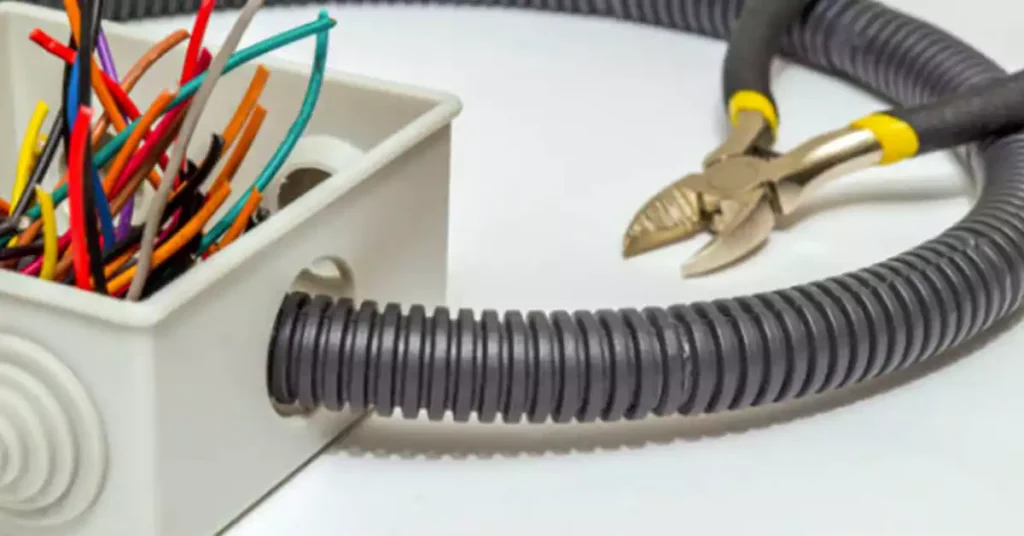
- Damage Assessment
Begin by evaluating the severity of the damage. Minor cracks or surface scratches can often be addressed with an epoxy-based sealant, designed for quick and secure repairs on small surfaces. For more substantial cuts or breaks, repair sleeves or specialized conduit tape may be necessary, while severely damaged sections should generally be replaced to ensure long-term reliability.
- Safety Precautions
Safety is paramount when working on any electrical component. Before beginning repairs, disconnect power at the circuit breaker to avoid shock hazards. Using insulated gloves and eye protection further minimizes the risk of injury during repairs, especially when handling sharp edges or adhesives.
- Patching Techniques
Various techniques are used depending on the extent of the damage:
Epoxy Sealant Repair (for Small Cracks and Scratches): Clean the damaged area thoroughly, apply epoxy sealant evenly, and allow it to cure fully for a strong, permanent seal.
Conduit Repair Sleeve (for Larger Cuts or Breaks): Remove the damaged section, place the sleeve over the area, and secure it per the manufacturer’s instructions, ensuring a tight seal on both ends.
Conduit Tape Repair (for Larger Gaps): Wrap the damaged area with layers of specialized PVC tape, creating an overlapping, press-tight seal that reinforces structural integrity.
- Post-Repair Inspections
After completing the repair, conduct a visual inspection to verify that all connections are secure and that there are no gaps or weaknesses in the repaired area. If necessary, consult an electrician to test the repair for functionality, ensuring it meets safety standards.
ENT Conduit Buying Guide
Beim Kauf eines HNO-Conduits sollten Sie folgende Faktoren berücksichtigen:
Qualität und Compliance: Achten Sie bei der Auswahl des HNO darauf, dass dieser die relevanten lokalen oder internationalen Sicherheits- und Qualitätsvorschriften einhält.
Size and Length: Determine the appropriate size and length of conduit needed for your specific application.
Rating: Ensure the conduit is rated for the intended application, such as indoor or outdoor use.
Kosten: Compare prices from different suppliers while considering the conduit’s quality and compliance.
Brand Considerations: Brand reputation can be an important factor in your buying decision. Look for established brands with a track record of manufacturing high-quality electrical products. Consider brands known for their expertise, experience, and commitment to product excellence.
Future Trends in Flexible PVC Conduit Technology
Flexible PVC conduit technology is rapidly evolving, with new advancements addressing the growing demands for safer, smarter, and more sustainable electrical installations. As buildings and infrastructure adopt modern requirements, flexible PVC conduits are being transformed to meet these challenges with innovations in material science, environmental resilience, and integration with smart technologies.
- Enhanced Fire Safety Standards
With fire safety becoming an increasingly critical aspect of construction codes, flexible PVC conduits are being developed with improved fire-retardant properties. Advanced fire-resistant coatings and materials are in the works to provide additional layers of safety, helping to slow down fire spread in sensitive environments. - Smart Technology Integration
The future of flexible PVC conduits includes seamless integration with smart systems for real-time monitoring and diagnostics. Future conduits could feature embedded sensors capable of tracking conditions like temperature and current flow, which would feed data directly into smart building management systems. This capability not only enhances safety but also allows for predictive maintenance, reducing downtime and improving energy efficiency. - Sustainability and Environmental Responsibility
Environmental sustainability is reshaping PVC production, with a shift toward recyclable, eco-friendly materials and processes. Efforts are being directed toward PVC compounds that can be more easily recycled, reducing waste, and promoting responsible resource use. Some manufacturers are even exploring bio-based or low-impact PVC alternatives, allowing for environmentally-conscious installations. - Advanced Durability and Weather Resistance
As installations are increasingly required to endure harsh weather and exposure to outdoor elements, flexible PVC conduits are being optimized for greater UV and corrosion resistance. These advancements ensure that conduits can withstand both physical impacts and environmental wear, offering reliable performance even in challenging conditions. - Customization and On-Demand Solutions
Flexible PVC conduit technology is moving toward greater customization options, supported by advanced manufacturing techniques like 3D printing. This allows contractors to produce specialized conduit shapes and sizes as needed, streamlining the installation process and reducing material waste. Customization makes it possible to tailor solutions for unique building needs and complex electrical layouts.
Abschluss
Insgesamt bietet das ENT-Rohr eine zuverlässige und flexible Lösung zum Schutz elektrischer Leitungen in verschiedenen Anwendungen. Dank seiner hervorragenden physikalischen und chemischen Leistung könnte es eine gute Wahl für elektrische Systeme in Wohngebäuden oder Gewerbegebäuden sein. Berücksichtigen Sie bei der Auswahl des ENT-Rohrs Größe, Länge, Konformitätscode, Projektanforderungen und andere notwendige Faktoren, um sicherzustellen, dass es Ihren spezifischen Anforderungen entspricht.
That’s all of the post. If you have any questions about the ENT electrical conduit, feel free to submit the contact form or write an email to us.



